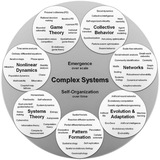📄 Big data need physical ideas and methods
https://arxiv.org/pdf/1412.6848v1
📌 If a person looks at WHITE paper through BLUE glasses, the paper will become BLUE in the eye of the person. Likewise, in the current study of big data which play the same role as the white paper being looked at, various statistical methods just serve as the blue glasses. That is, results obtained from big data often depend on the statistical methods in use, which may often defy reality. Here I suggest using physical ideas and methods to overcome this problem to the greatest extent. This suggestion is helpful to development and application of big data.
#Data_Analysis , #Statistics and #Probability (physics.data-an)
https://arxiv.org/pdf/1412.6848v1
📌 If a person looks at WHITE paper through BLUE glasses, the paper will become BLUE in the eye of the person. Likewise, in the current study of big data which play the same role as the white paper being looked at, various statistical methods just serve as the blue glasses. That is, results obtained from big data often depend on the statistical methods in use, which may often defy reality. Here I suggest using physical ideas and methods to overcome this problem to the greatest extent. This suggestion is helpful to development and application of big data.
#Data_Analysis , #Statistics and #Probability (physics.data-an)
📝 The many facets of community detection in complex networks
Michael T. Schaub, Jean-Charles Delvenne, Martin Rosvall, Renaud Lambiotte
https://arxiv.org/pdf/1611.07769v1
📌 ABSTRACT
Community detection, the decomposition of a graph into meaningful building blocks, has been a core research topic in network science over the past years. Since a precise notion of what constitutes a community has remained evasive, community detection algorithms have often been compared on benchmark graphs with a particular form of community structure, and classified based on the mathematical techniques they employ. However, this can be misleading because apparent similarities in their mathematical machinery can disguise entirely different objectives. Here we provide a focused review of the different motivations that underpin community detection. This problem-driven classification is useful in applied network science, where it is important to select an appropriate algorithm for the given purpose. Moreover, highlighting the different facets of community detection also delineates the many lines of research, and points out open directions and avenues for future research.
#Social and #Information #Networks (cs.SI); #Data_Analysis, #Statistics and #Probability (physics.data-an); #Physics and #Society (physics.soc-ph
Michael T. Schaub, Jean-Charles Delvenne, Martin Rosvall, Renaud Lambiotte
https://arxiv.org/pdf/1611.07769v1
📌 ABSTRACT
Community detection, the decomposition of a graph into meaningful building blocks, has been a core research topic in network science over the past years. Since a precise notion of what constitutes a community has remained evasive, community detection algorithms have often been compared on benchmark graphs with a particular form of community structure, and classified based on the mathematical techniques they employ. However, this can be misleading because apparent similarities in their mathematical machinery can disguise entirely different objectives. Here we provide a focused review of the different motivations that underpin community detection. This problem-driven classification is useful in applied network science, where it is important to select an appropriate algorithm for the given purpose. Moreover, highlighting the different facets of community detection also delineates the many lines of research, and points out open directions and avenues for future research.
#Social and #Information #Networks (cs.SI); #Data_Analysis, #Statistics and #Probability (physics.data-an); #Physics and #Society (physics.soc-ph
